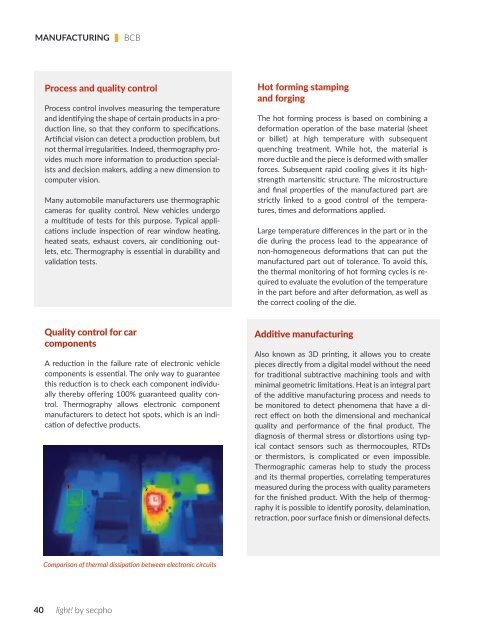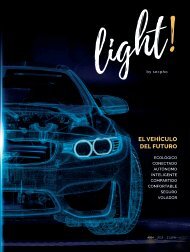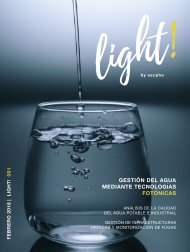light! 004 | The car of the future
You also want an ePaper? Increase the reach of your titles
YUMPU automatically turns print PDFs into web optimized ePapers that Google loves.
MANUFACTURING<br />
BCB<br />
Process and quality control<br />
Process control involves measuring <strong>the</strong> temperature<br />
and identifying <strong>the</strong> shape <strong>of</strong> certain products in a production<br />
line, so that <strong>the</strong>y conform to specifications.<br />
Artificial vision can detect a production problem, but<br />
not <strong>the</strong>rmal irregularities. Indeed, <strong>the</strong>rmography provides<br />
much more information to production specialists<br />
and decision makers, adding a new dimension to<br />
computer vision.<br />
Many automobile manufacturers use <strong>the</strong>rmographic<br />
cameras for quality control. New vehicles undergo<br />
a multitude <strong>of</strong> tests for this purpose. Typical applications<br />
include inspection <strong>of</strong> rear window heating,<br />
heated seats, exhaust covers, air conditioning outlets,<br />
etc. <strong>The</strong>rmography is essential in durability and<br />
validation tests.<br />
Hot forming stamping<br />
and forging<br />
<strong>The</strong> hot forming process is based on combining a<br />
deformation operation <strong>of</strong> <strong>the</strong> base material (sheet<br />
or billet) at high temperature with subsequent<br />
quenching treatment. While hot, <strong>the</strong> material is<br />
more ductile and <strong>the</strong> piece is deformed with smaller<br />
forces. Subsequent rapid cooling gives it its highstrength<br />
martensitic structure. <strong>The</strong> microstructure<br />
and final properties <strong>of</strong> <strong>the</strong> manufactured part are<br />
strictly linked to a good control <strong>of</strong> <strong>the</strong> temperatures,<br />
times and deformations applied.<br />
Large temperature differences in <strong>the</strong> part or in <strong>the</strong><br />
die during <strong>the</strong> process lead to <strong>the</strong> appearance <strong>of</strong><br />
non-homogeneous deformations that can put <strong>the</strong><br />
manufactured part out <strong>of</strong> tolerance. To avoid this,<br />
<strong>the</strong> <strong>the</strong>rmal monitoring <strong>of</strong> hot forming cycles is required<br />
to evaluate <strong>the</strong> evolution <strong>of</strong> <strong>the</strong> temperature<br />
in <strong>the</strong> part before and after deformation, as well as<br />
<strong>the</strong> correct cooling <strong>of</strong> <strong>the</strong> die.<br />
Quality control for <strong>car</strong><br />
components<br />
A reduction in <strong>the</strong> failure rate <strong>of</strong> electronic vehicle<br />
components is essential. <strong>The</strong> only way to guarantee<br />
this reduction is to check each component individually<br />
<strong>the</strong>reby <strong>of</strong>fering 100% guaranteed quality control.<br />
<strong>The</strong>rmography allows electronic component<br />
manufacturers to detect hot spots, which is an indication<br />
<strong>of</strong> defective products.<br />
Additive manufacturing<br />
Also known as 3D printing, it allows you to create<br />
pieces directly from a digital model without <strong>the</strong> need<br />
for traditional subtractive machining tools and with<br />
minimal geometric limitations. Heat is an integral part<br />
<strong>of</strong> <strong>the</strong> additive manufacturing process and needs to<br />
be monitored to detect phenomena that have a direct<br />
effect on both <strong>the</strong> dimensional and mechanical<br />
quality and performance <strong>of</strong> <strong>the</strong> final product. <strong>The</strong><br />
diagnosis <strong>of</strong> <strong>the</strong>rmal stress or distortions using typical<br />
contact sensors such as <strong>the</strong>rmocouples, RTDs<br />
or <strong>the</strong>rmistors, is complicated or even impossible.<br />
<strong>The</strong>rmographic cameras help to study <strong>the</strong> process<br />
and its <strong>the</strong>rmal properties, correlating temperatures<br />
measured during <strong>the</strong> process with quality parameters<br />
for <strong>the</strong> finished product. With <strong>the</strong> help <strong>of</strong> <strong>the</strong>rmography<br />
it is possible to identify porosity, delamination,<br />
retraction, poor surface finish or dimensional defects.<br />
Comparison <strong>of</strong> <strong>the</strong>rmal dissipation between electronic circuits<br />
40 <strong>light</strong>! by secpho












